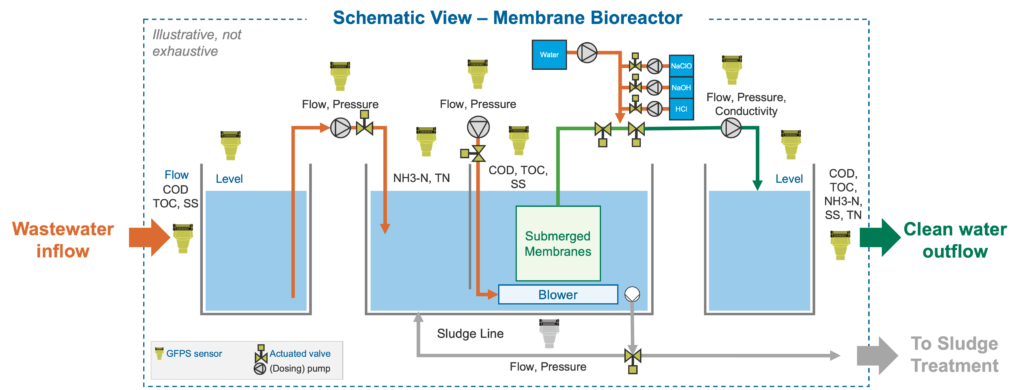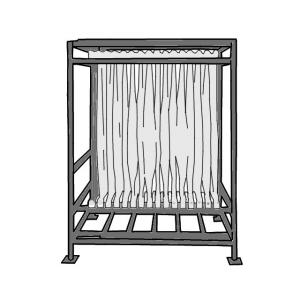Membrane Bioreactors Discussed: Reliable Solutions for Tidy Water
Membrane layer bioreactors (MBRs) have actually become a sophisticated service for attending to the pushing difficulties of wastewater therapy. By incorporating organic procedures with sophisticated membrane layer filtering, MBRs not just improve the high quality of treated water however also decrease the spatial requirements of treatment facilities. As environmental concerns magnify, the function of MBR innovation in promoting sustainable water management comes to be significantly substantial. Nonetheless, the complexities of their operation, advantages, and prospective applications merit a closer evaluation to completely understand their influence on the future of water treatment.

What Are Membrane Bioreactors?
Membrane bioreactors (MBRs) are sophisticated wastewater therapy systems that combine biological degradation procedures with membrane filtering innovation. This integration permits the reliable elimination of impurities from water, making MBRs a recommended selection in numerous applications, consisting of local wastewater treatment and industrial effluent administration.

Among the vital benefits of MBRs is their ability to create high-quality effluent, typically ideal for reuse in irrigation or industrial processes. Furthermore, MBRs call for a smaller sized footprint compared to traditional therapy systems, making them ideal for metropolitan setups where space may be limited.
Moreover, MBRs can effectively deal with varying influent loads and are less vulnerable to the impacts of hazardous shocks. These attributes add to their expanding appeal as a lasting remedy for resolving the increasing need for tidy water while minimizing environmental impacts.
How Membrane Bioreactors Job
While the procedure of membrane layer bioreactors (MBRs) might appear facility, it basically focuses on the harmony between biological processes and membrane purification. MBRs incorporate an organic therapy process, usually triggered sludge, with a membrane separation unit to deal with wastewater successfully.
In an MBR system, wastewater is initial presented into a bioreactor where microbes deteriorate organic matter and other pollutants. The biological activity lowers the focus of contaminants while promoting the development of biomass. Following this biological therapy, the combined liquor is subjected to membrane purification, which can be microfiltration or ultrafiltration, relying on the preferred effluent quality.
The membrane layers work as a physical obstacle, allowing water and tiny solutes to pass while preserving suspended solids and larger particles. This allows the system to maintain a high focus of biomass within the reactor, enhancing the treatment performance.
Additionally, the constant splitting up of cured water from the biomass promotes a small layout and decreases the footprint of the therapy facility. Overall, the mix of biological destruction and membrane purification in MBRs leads to efficient and trustworthy wastewater treatment, ensuring high-grade effluent ideal for different applications.
Benefits of MBR Innovation
One of the crucial advantages of membrane bioreactor (MBR) modern technology is its capability to generate top quality effluent with a dramatically decreased impact compared to traditional wastewater therapy methods. MBR systems successfully integrate biological treatment and membrane layer filtering, resulting in remarkable elimination of contaminants, consisting of put on hold solids, pathogens, and raw material. This capability results in effluent that usually meets or surpasses rigorous regulatory standards for reuse and discharge.
Furthermore, MBR modern technology enables greater biomass focus, which enhances the treatment effectiveness and lowers the called for reactor volume. This small style is especially beneficial in urban areas where room is restricted. The functional flexibility of MBR systems likewise means they can adapt to varying influent high qualities and flow rates, making them appropriate for a vast array of applications.
In addition, the lowered sludge manufacturing connected with MBR procedures adds to decrease functional and upkeep prices. The membrane layers act as a physical obstacle, lessening the threat of blocking and allowing longer functional periods between cleaning. Overall, the advantages of MBR technology make it an attractive solution for lasting wastewater therapy, resolving both environmental worries and the requirement for effective resource management.
Applications of Membrane Bioreactors
With their convenience and performance, membrane layer bioreactors (MBRs) discover applications across numerous fields, consisting of local wastewater therapy, industrial processes, and also water recovery. In local settings, MBRs provide a portable remedy for treating wastewater, efficiently removing impurities while all at once creating premium effluent that satisfies stringent governing requirements. This makes them particularly suitable for locations with limited room.
In commercial applications, MBR technology is made use of for dealing with process water, specifically in industries such as food and drink, drugs, and petrochemicals. These markets gain from MBRs' capacity to deal with high natural tons and their effectiveness in recouping valuable sources from wastewater, such as nutrients and water.
Furthermore, MBRs play a crucial duty in water reclamation campaigns, allowing the reuse of dealt with wastewater for irrigation, commercial processes, or also as potable water after additional treatment (Membrane Bioreactor). Their efficiency in removing toxins and pathogens makes them a reputable option for ensuring water high quality in various reuse applications
Future of Water Treatment Solutions
The future Click Here of water therapy solutions is positioned for transformative advancements driven by technological technology and enhancing ecological recognition. As global water shortage comes to be a pushing issue, brand-new approaches, consisting of membrane bioreactor (MBR) systems, are set to play an essential role in boosting the efficiency and sustainability of water treatment procedures.
Emerging innovations such as fabricated intelligence and equipment learning are expected to enhance therapy procedures, enabling real-time tracking and anticipating upkeep. This will certainly boost the overall reliability and efficiency of water treatment centers. In addition, advancements in membrane materials, such as graphene and nanofiltration, promise to boost permeation prices and lower fouling, bring about reduced power consumption find this and operational costs.
Furthermore, the combination of renewable resource sources into water treatment plants will add to greener techniques. The round economic situation version will certainly likewise get traction, encouraging the recovery of beneficial sources from wastewater, such as nutrients and power.
Final Thought

Membrane layer bioreactors (MBRs) have actually emerged as an innovative option for resolving the pushing challenges of wastewater treatment. By integrating organic procedures with sophisticated membrane layer filtering, MBRs not only improve the high quality of treated water yet additionally decrease the spatial demands of therapy centers.One of the vital benefits of membrane layer bioreactor (MBR) innovation is its ability to generate premium effluent with a dramatically minimized impact compared to conventional wastewater therapy techniques.With their flexibility and efficiency, weblink membrane bioreactors (MBRs) discover applications across numerous sectors, consisting of community wastewater treatment, commercial processes, and even water reclamation.In final thought, membrane bioreactors stand for a significant development in wastewater therapy modern technology, integrating organic procedures with effective membrane layer filtration to produce high-quality effluent.